The June 2022 Author Interview came about as a fortuitous accident, of sorts. I recently attended the FL SCBWI conference in Orlando (my roundup post on that is here) and completely at random, I ended up at Pat Zietlow Miller’s lunch table at the Hilton Orlando/Lake Buena Vista not once but twice! Pat’s interesting stories there in addition to her terrific keynote and panel discussions told me that she HAD to be the subject of the next Author Interview.
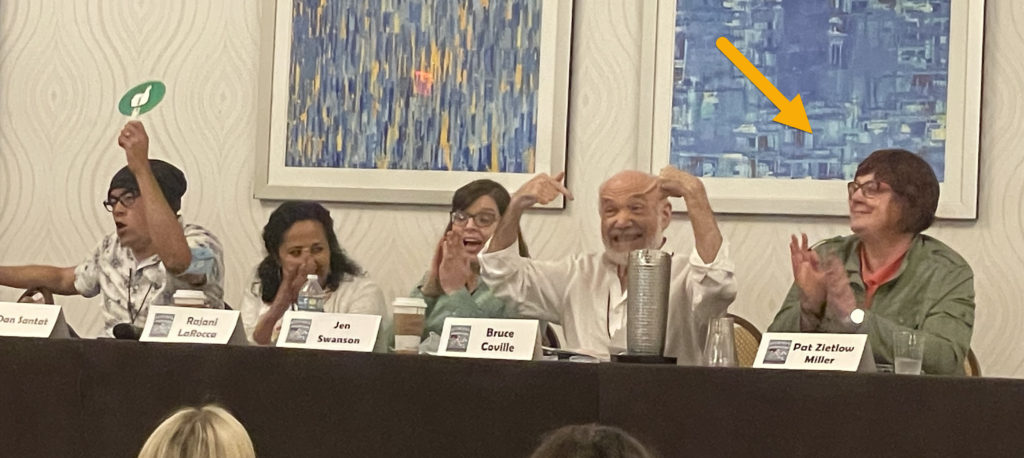
I’m not at all ashamed to admit that I used the Wisconsiner-to-Wisconsiner secret connection to make this interview happen. (I mentioned cheese curds, supper clubs, and Friday fish fries–in that exact order.) And it worked! Unsurprisingly, Pat even emailed me the Monday after the conference before I had a chance to follow up with her with an official invitiation to be on OPB. Talk about being a pro!
Now, you probably already know all about Pat Zietlow Miller, but here’s a very quick refresher…
- She wanted to be a writer ever since her seventh-grade English teacher read her paper about square-dancing skirts out loud in class and said: “This is the first time anything a student has written has given me chills.”
- She started out as a newspaper reporter and wrote about everything from dartball and deer-hunting to diets and découpage. Then, she joined an insurance company–and then another–and edited their newsletters and magazines.
- These days, Pat focuses on her favorite thing–writing picture books. She’s sold 23 books and is always working on more.
- She has one wonderful husband, two delightful daughters, and two well-pampered cats.
- Pat’s favorite things are:
- Colors – Purple and blue.
- Animals – Cats and kittens.
- Food – Potatoes, served almost any way. And dark chocolate. (But separately, not mixed in with the potatoes.) And a really good omelet.
- Flowers – Tulips and pansies.
- Activities – Reading. Walking around exploring new places. Singing along to the radio. Learning new things.
With that, let’s zip ahead to the interview to hear from my new Wisconsin buddy herself. Onward!
RVC: Like so many kidlit writers, it seems as if you had an important early experience with a teacher that really got things going for you.
PZM: I had a couple teachers that were amazingly supportive of me early on. The first was in fourth grade where our teacher had us keep a journal. We’d write little things based on prompts, and then she’d make comments. These were just two- or three-paragraph things, but I remember my fourth-grade teacher, Chloe Wandschneider, telling me that I was an excellent writer. I remember being so proud.
When I went to high school, I had several teachers that were great, too. I had a journalism advisor when I wrote for the school paper, and he was amazing and encouraging, though also really hard on me–he really pushed me. Then I had another teacher who told me that my work reminded her of Nora Ephron, which is probably the best compliment I ever got in my entire life because Nora Ephron is amazing.
So, yeah, I feel like throughout my entire career, I had teachers that supported me and encouraged me.
RVC: I love it when teachers make such a difference. Now, what were some of the things you were reading back then?
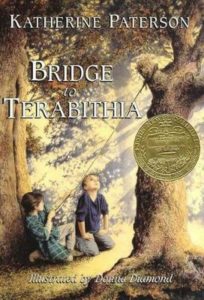 PZM: I read everything. I read all the Encyclopedia Brown books and read the Boxcar Children’s series. I read Anne of Green Gables. I read Bridge to Terabithia and The Westing Game–those are my two favorites. Then I read a lot of stuff written for adults. My mom just gave me a library card and said, “Go for it!”
PZM: I read everything. I read all the Encyclopedia Brown books and read the Boxcar Children’s series. I read Anne of Green Gables. I read Bridge to Terabithia and The Westing Game–those are my two favorites. Then I read a lot of stuff written for adults. My mom just gave me a library card and said, “Go for it!”
After my teacher said that my writing reminded her of Nora Ephron, I read everything she’d ever written because I didn’t know who she was. Doing so much reading made me a much better writer.
RVC: You’re one of the few writers I’ve interviewed here who’s talked about Encyclopedia Brown. That was one of my early favorites, too. That and The Great Brain.
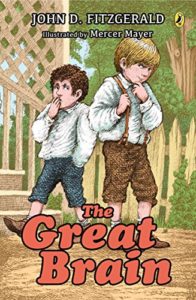 PZM: I should have mentioned The Great Brain. I read ALL The Great Brain books.
PZM: I should have mentioned The Great Brain. I read ALL The Great Brain books.
RVC: Yeah, those are amazing. But let’s talk about the transition from when you went from being a student to being a professional writer.
PZM: When I started going to school at UW-Oshkosh. I thought I was going to be a sports writer for the Chicago Tribune–that was my goal. I’d been a sports editor of my high school paper, I’d won some sports writing awards from the local press association, and I’d worked part time through high school and college at my local daily newspaper as a sports writer. I covered American Legion baseball games and got paid $10 to cover doubleheaders and I thought I was rich!
RVC: I can imagine. Ten buckeroonis was a lot to a kid back then.
PZM: At college, I double majored in English because I loved English, too. Honestly, it never occurred to me that I could have a book published because I didn’t know anybody who did. I mean, it just seemed like those couldn’t be real people. So, I graduated and worked as a full-time sportswriter in Wisconsin for a while.
I did try writing a picture book while I was in college just for fun, because I was still reading them. I sent it off to one publisher. I just picked a publisher’s address at random, and I mailed it off. I got a rejection. Writing more picture books wasn’t something I was seriously thinking would be my career. That didn’t happen until I was 39 when I wondered, “ ‘Okay, why couldn’t it be my career?” At that point, I was older and more mature. The internet existed. I knew I could figure it out.
RVC: Here at OPB, I run into quite a few journalists who moved into kidlit after making a name for themselves in newspapers and/or magazines, but you’re the first I can recall who did sports writing. What appealed about sports writing?
PZM: My dad got Sports Illustrated when I was growing up, and I read everything in it. Jill Lieber from Neenah, Wisconsin, wrote for them. I grew up in Oshkosh, Wisconsin. I remember thinking how cool it was that she was the only woman who wrote for Sports Illustrated, and she was 30 minutes from my house. That showed me that maybe it’d be possible for me.
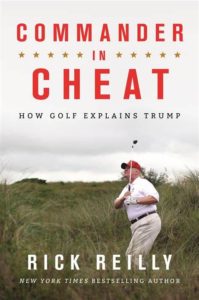 I also read Frank Deford and Rick Reilly and I just loved how they put words together. They were such good writers. It inspired me, and I was already a big sports fan. I watched the [Green Bay] Packers and the [Milwaukee] Bucks. I was really into sports at that point. I liked the idea of combining the two things [sports and writing] together.
I also read Frank Deford and Rick Reilly and I just loved how they put words together. They were such good writers. It inspired me, and I was already a big sports fan. I watched the [Green Bay] Packers and the [Milwaukee] Bucks. I was really into sports at that point. I liked the idea of combining the two things [sports and writing] together.
RVC: What’s the best lesson from being a sportswriter that you use on a regular basis in your kidlit?
PZM: Don’t get annoyed when someone edits your copy.
Back then, I wrote up my story, it’d go off to the sports editor, he’d do whatever he did with it, and then it’d go to the copy desk, and they did whatever they did to it, and I learned pretty quickly to take the edits. I’d look at it and say, “How can I do better next time so they don’t have to edit it as much?” I got very good at writing stories that could get through their process. It made me a better writer. I also learned how to write quickly and not be overly precious about it because I had a deadline. That helps a lot, too. These days, I can sit down and crank out at least a solid first draft.
RVC: How many years were you in the insurance business?
PZM: 29 years. It’s somewhere I never thought I’d end up. I worked in communications the whole time, so at least it was writing or editing. There was a brief time when I tried to be an actual insurance person and worked in underwriting. That was a dismal failure.
Underwriting is a great career path, but it’s not MY career path.
RVC: Gotcha. But these days, your only job is writing, right?
PZM: For almost a year now.
RVC: What’s the most surprising thing about it?
PZM: I have a huge sense of relief.
RVC: How so?
PZM: Working at an insurance company was a great career path for my family, and I worked with great people, and I learned a lot. I’m also incredibly well insured for a writer because I learned a lot about insurance. But I have such a sense of relief that I’m not in corporate meetings anymore. I’m not listening to people talk and thinking How can you possibly be using that jargon? and editing what they’re saying in my head. So, that’s huge.
RVC: I thought I was the only person who edited others in my own head. Whew!
PZM: The second thing is that I can set my own schedule. I don’t have to work from eight to five. I don’t have to get dressed up to go to work, unless it’s for a Zoom meeting, so I can wear whatever I want to wear. It’s a great sense of freedom to be able to work on what makes me happy whenever and however I feel inspired to do so.
RVC: Let’s talk about writerly routines. What does a typical day look like for you as a writer?
PZM: When I started, I thought I should have a routine. I felt guilty for not having one for a while, like I was doing this wrong. Then I realized that as long as I got my stuff done, it didn’t matter if I had a routine or not.
I always knew I wasn’t a morning person and working on my own has cemented that fact. So, I no longer try to get up at the crack of dawn. Instead, I get up around 9:30 or 10am. That works for me, unless I have to be someplace. Then I usually go through my email because a lot of my time is responding to things that people send me–questions, requests from editors, or whatever.
RVC: I often tell my students–who don’t always believe me–that at this point in my career, about 60–70% of my “writing time” is actually spent on the business of writing instead of the fun writing.
PZM: Yes! That’s true. I’m pretty active on social media, too. I have to figure out What am I going to post today? And What am I going to respond to? This year, especially because I’ve got five books coming out, a lot of my time has been going to promotion. I’m always doing an interview or a blog post or being on a panel or something. With the time that’s left, I sit down and think What do I have to revise for an editor?
I hope to make a little more time to focus on creating new things because some days it feels like an afterthought. It really should be one of my first things. I’m trying to do better.
RVC: How many current projects do you have?
PZM: I’ve got three things that are currently out on sub that editors are looking at but haven’t sold and they haven’t responded to yet. I think they’re done. Of course, if I don’t get a good response, I’ll go back and work on them more.
I’ve got three things that I’m also revising that editors haven’t offered on. But they’ve said, Hey, if you make these tweaks, I’d like to see it again. So, I’ve got to go back and revise. I’ve also got three or four ideas of new stuff that I want to write. Altogether, that’s probably like nine or ten things in total floating around.
RVC: When you first started off, were you using an agent?
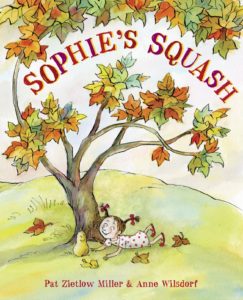 PZM: I sold Sophie’s Squash without an agent, unsolicited through the slush pile, which obviously limited the number of places I could send it. I think I sold it on maybe one of the very last places that I could have sent it to!
PZM: I sold Sophie’s Squash without an agent, unsolicited through the slush pile, which obviously limited the number of places I could send it. I think I sold it on maybe one of the very last places that I could have sent it to!
RVC: That’s yet another argument for sticking with a project you believe in.
PZM: After I sold Sophie’s Squash, I did get an agent. An aspiring writer friend of mine–Jessica Vitalis, who now has a great middle grade out–said, “You really have to try to get an agent.” She pushed me, so that’s what I did. It was the best advice I could have gotten because having an agent makes my publishing life so much easier.
RVC: Let’s talk about the making of Sophie’s Squash.
PZM: I wrote an early draft of it, then I worked it through my critique group. I even paid for a couple of professional critiques. One of the women doing a paid critique, Jill Esbaum, said–and I think these were her exact words–“This is gold!” But then she basically told me I needed to redo the plot and have a better ending. So, I rewrote it, and started sending it out. I got a lot of rejections. I got a lot of close calls, too, with little notes saying, “This is cute, but not for us.” It made it to acquisitions twice but didn’t get picked up.
I had different versions of it. I had one version that was a little more happy, and I had one version that was a little more sad. When it finally sold, I didn’t remember which version I had sent to that particular editor.
RVC: Hah! I’ve been there.
PZM: That story alone probably got 15 to 20 rejections before it sold. I got 126 rejections overall on everything I was sending out before I sold my first story, but Sophie’s Squash got 15 or 20.
RVC: Wow, thanks for sharing that. I worry early-career writers get upset and feel like quitting when they hit double-digit rejections. Since you’re being so open and honest, I’m going to ask a hard question. Here it comes–are you still getting rejected these days?
PZM: Oh, all the time. Just last week, I got probably four rejections because I’ve got stuff out on sub[mission]. The rejections are usually nicer. My agent will send me what the editor said, which is something like I’m a good writer but that they didn’t connect with it or they didn’t love it or they couldn’t see a vision of it.
I’ve always been good about rejections. I mean, they’re no fun, but they’ve never totally messed me up or made me question my place in the world. They’re just part of the process. I think that’s a good way to look at it. They’re just part of the road you go down until you find somebody who loves your story as much as you do.
RVC: But even if an agent or editor loves your story, they’re still going to want changes.
PZM: I think that when people get into publishing, a lot of them don’t realize how much they’re going to have to revise even after an editor buys the story and loves it. You still spend a ton of time revising. You’ve got to be okay with it. You can’t say, “How DARE they question this beautiful, perfect thing that I wrote!” There are so many different ways you can tell the story effectively.
RVC: What about those who think that revising a story makes it less theirs? I hear that worry/complaint a lot.
PZM: That’s wrong because you’re the one revising it. You’re wondering, thinking, choosing how to change it. It’s still YOUR story.
RVC: Which of your books had the most rigorous revision process?
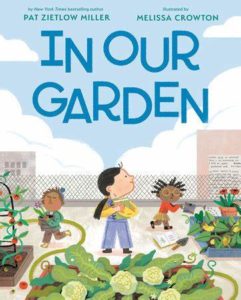 PZM: In Our Garden. I revised it 24 times.
PZM: In Our Garden. I revised it 24 times.
RVC: How many of those happened after you signed a contract?
PZM: The editor who pulled Sophie’s Squash from the slush pile, Stephanie Pitts, asked me if I’d write a book about a school rooftop garden. I said, “Sure!” and I wrote a draft. All 24 revisions were for Stephanie. Without a contract.
I was to the point where I was quietly and politely saying to myself, “Come ON!” But I knew since she had asked me for it that the odds were good that if I could come up with the version that we both liked that she’d take it. And, I love how it turned out. It’s beautiful.
RVC: In looking at what critics and regular readers say about your books, they often talk about heart. What is that, and perhaps more important, how does a writer create it?
PZM: Heart is one of the most important things a picture book can have. To me, heart is this universal emotion such that anybody–whether they’re 4 or 94–can read a book and say, “Oh, I felt that way!” Something in the book resonates with them and reminds them of the common humanity they share with everyone else. Happiness, sadness, hope, nostalgia–it’s some intense universal emotion.
The way I think about adding it is asking, “What do I want the reader to take away from this book that I’m writing?” Because you can have beautiful language, and it can read out loud gorgeously, but it has to make you feel something. You want the reader to close the book and have something linger with them, so they want to go back and read it again. That’s the heart.
Then I ask, “What are the biggest emotions I remember from being a kid?” Not necessarily what led to those emotions, but what ARE the emotions? And I think about how I might channel some of that into what I’m writing. Sometimes you only need a line or two. It doesn’t have to be dripping with whatever your emotion is–you can get a lot of emotion out of the right line being in just the right place.
RVC: It’s getting the right line in the right place that makes a book a hit. And speaking of hits…what was it like the first time that you realized you were a New York Times bestselling author?
PZM: This is one of my favorite stories. It was 2018, and I was in my 50s. I’d just found out that I needed to have my tonsils out. Getting your tonsils out at any age isn’t fun, but when you’re an adult, it’s worse. Be Kind had come out in February and this was now August. The day after I had my tonsils out, I was at home in bed, feeling like I was going to die.
My phone buzzed. It was my agent. She KNEW that I was having this done. I was thinking Why is she calling me? Still, I pushed the button. She said, “Don’t talk. Don’t say anything. But I have to tell you that Be Kind made the New York Times bestseller list.” So, I did what any logical person would do. I screamed. Major pain! I was still on massive narcotic medicine so the whole situation didn’t make a lot of sense.
I hung up. Later, it got announced, and all of a sudden, my phone is vibrating off the table because people are texting me, calling me, and tagging me on social media. I felt so good emotionally and so bad physically. I finally handed the phone to my husband and said, “This is making me feel worse.” It was just this weird balance of life.
RVC: Great story. Now, you didn’t up and quit your day job right after that.
PZM: No. That was in 2018, and I quit my job for good and became a full-time writer in 2021.
RVC: I’m not sure most would wait three years.
PZM: Some people are very fortunate. Maybe they have a spouse or a partner or someone who has regular, consistent, predictable income–enough where they could deal with the ups and downs of publishing money, which is never predictable. I provided more than half of our family income, so I couldn’t just quit.
My husband and I started meeting with a financial planner, especially after I got the first couple of royalty checks after hitting the New York Times list which were bigger than I ever thought they could be. I kept thinking, “It’s not going to last forever.” With the financial planner, we did a whole budget. What were we spending now? What were we thinking we’d spend in the future once both our kids weren’t living at home? What were our goals for retirement? What did we already have?
We spent over a year talking to them and finally they entered it all into this computer program. And they said, “You could leave your job now.” I wanted to do it, but I waited a couple more months–until June–just because I wanted to get everything dotted and crossed. When I left my job, I knew exactly how much money I needed to bring in each year to meet my expenses. I also had a plan. If royalties brought in that much, then awesome! If they didn’t, I was going to make up the difference through speaking engagements, school visits, or whatever. I had a plan, which made me feel better about my decision.
RVC: You’ve mentioned this before–you’ve got five books coming out this year. How do you handle promoting so many?
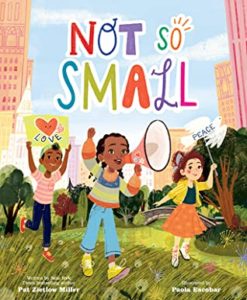 PZM: Right now, one just came out recently–Not So Small, my social justice, activism, protest picture book. So, I’m talking about that one. But then I’ve got two coming out in June, so I’m starting to talk about them. It’s been hard balancing five, because I think five is too many. I know that sounds like a “Poor me!” kind of thing, but it’s hard to do.
PZM: Right now, one just came out recently–Not So Small, my social justice, activism, protest picture book. So, I’m talking about that one. But then I’ve got two coming out in June, so I’m starting to talk about them. It’s been hard balancing five, because I think five is too many. I know that sounds like a “Poor me!” kind of thing, but it’s hard to do.
Normally, I would have one or two [books come out in a year] and I’d really focus on them. Now, I always feel like I’m either over-promoting and annoying people or I’m not giving each book its own particular due.
RVC: When I interview productive authors, they often face the same challenge.
PZM: Can I talk about my favorite of the five?
RVC: That was my next question, so sure!
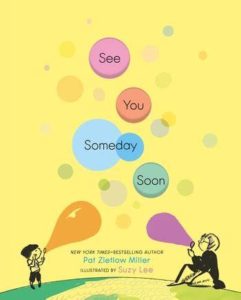 PZM: See You Someday Soon is my favorite. Suzy Lee did the art, and she put die cuts in the cover and throughout the book. The holes go all the way through the pages that have die cuts. It’s one of the most beautiful picture books I’ve ever seen. Suzy is amazing. I’m really, really proud.
PZM: See You Someday Soon is my favorite. Suzy Lee did the art, and she put die cuts in the cover and throughout the book. The holes go all the way through the pages that have die cuts. It’s one of the most beautiful picture books I’ve ever seen. Suzy is amazing. I’m really, really proud.
This is another story where I revised the book probably eight or nine times specifically for an editor. The story ended up so much the better for it, though. It started out as a character-driven story and it ended up being more of a lyrical poem. It’s so much better than it was, and I couldn’t have been more excited about this particular book. I actually wrote a blog post about the revision process and how everything went down.
RVC: That’s a Roaring Brook Press book? Who was your editor there?
PZM: Connie Hsu.
RVC: I interviewed her at OPB a year or so back. She was great.
PZM: I like all my editors, but Connie is especially wonderful. She helps me be the best version of myself as a writer. Before she got a job at a different house, she was the original editor for Wherever You Go, and she was the editor for Be Kind, which is a book that made the New York Times bestseller list.
RVC: Let’s talk rhyme. How do you get the words to sing off the page?
PZM: I do a ton of reading my stories out loud, you know, just sitting at my computer, staring at it, reading the words out loud. I really try to listen and think about how the words sound. I think about what they make the reader feel. And then I ask, “Are they as simple as they can be?” Because it’s for kids. Now, when I say “simple,” I don’t mean you have talk down to kids, but rather be simple and clear. The perfect word in the perfect spot. That’s what I’m going for.
It’s more of a feeling that something is working or not. I don’t know how to explain it other than that I can just feel when it’s right.
RVC: Is rhyming something that comes naturally to you?
PZM: As much as I like rhyming books–and I’m very proud of the rhyming books I’ve written–I usually try to talk myself out of rhyming because it makes the initial draft harder, and it makes revising harder. It makes everything harder because rhyme has to be perfect. I do a lot of pulling my hair out when I rhyme. But when you get it right, it’s the best feeling in the world.
I’ve never taken a prose story and said, “Oh, this ought to rhyme.” If a story comes to me initially in rhyme and I can’t talk myself out of it, then I continue. I spend a lot of time tapping out the rhythm when I write. I spend a lot of time clapping–I’m sure I’m just a joy to live with while I’m doing all of this! I’ll also go to Rhyme Zone for the perfect word to make it a line work.
RVC: And then there’s meter.
PZM: I was an English major in college which means I learned all about iambic pentameter, but I can’t look at something and say, “Oh, that’s…whatever.” I can tell whether it’s consistent and whether it works, even if I don’t know the official name for the metric structure. You have to be able to hear how the language sounds, and then has to sound like a story. You can’t twist the language to make the rhyme work. You don’t want to sound like Yoda by moving things around. It’s got to sound natural and conversational, yet also rhyme. That’s the hardest part of getting it right.
RVC: In your mind, who sets the bar for picture book rhymes?
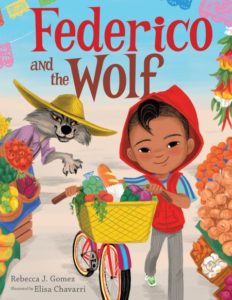 PZM: Several people come to mind. Jill Esbaum is an amazing rhymer. There’s Lisa Wheeler and Karma Wilson. Rebecca J. Gomez is an excellent rhymer, as well. She wrote Federico and the Wolf which rhymes and has words in Spanish! Two languages, and it rhymes, and the meter is spot on.
PZM: Several people come to mind. Jill Esbaum is an amazing rhymer. There’s Lisa Wheeler and Karma Wilson. Rebecca J. Gomez is an excellent rhymer, as well. She wrote Federico and the Wolf which rhymes and has words in Spanish! Two languages, and it rhymes, and the meter is spot on.
RVC: Where do you think most picture book writers go wrong with rhyme?
PZM: One issue is that they think it has to rhyme because they grew up reading Dr. Seuss. It absolutely does not have to rhyme. They also think that if the last word in each of their sentences rhymes, that’s a rhyming book. Well, no, because you’ve got to have the meter, too. There’s got to be a rhythm that’s consistent and works. And then they try to use what I call near rhyme like “tune” and “zoom.” They both have a similar sound, but they don’t rhyme. They’re a close rhyme, but not a perfect rhyme. In picture books, you need to get it perfect.
RVC: What’s your single best secret weapon tip for making rhyme work?
PZM: You’ve got to get the meter right. And you’ve got to be able to count it out. Like I said, the tapping and clapping helps me. But when I’m really stuck, I’ll go through and highlight the stressed syllables. That helps me see the pattern I’ve got going and where I’m going wrong. It’s a very visual way of looking at your manuscript.
RVC: Great idea.
PZM: If you’re just massively struggling, try writing it in prose. In fact, a lot of times when I do critiques for people, I’ll say, “Have you tried writing this in prose?” At least give it a shot. A rhyming story has to have the same quality of plot that a non-rhyming story does. Just because it’s rhyming doesn’t mean you can skip telling a good story.
Here’s another thing. When you’ve got your stanzas, it can help to go to the side of each and [in the margins] write a single sentence saying what’s happening in the stanza. Then look at your sentences and ask, “Is this enough of a story arc? Or am I saying the same thing on consecutive stanzas and there’s no rising action and falling action?”
RVC: You’ve got a reputation for doing great school visits. Do you still do a lot of them?
PZM: Far less than I used to, partially because of the pandemic. I’m not like some authors who get the bulk of their income from them. Honestly, doing them makes me incredibly anxious. I’ve learned to manage it, and I enjoy them once I’m actually there doing them, but I prefer to write more than give school visits.
RVC: What’s your best tip for giving a great school visit?
PZM: Pre-planning, such as working with the school and asking, “Can you send me an agenda? What are you specifically expecting from me?” Sometimes I’d show up as we’d agreed and I find out they scheduled three extra presentations they hadn’t told me about.
Once I’m there with the kids, they’re excited, and I’m happy to be with them. That takes you a long way because kids are fun. If you can meet them where they are and show them that you’re excited to be there, it goes well.
RVC: I just saw you a few weeks back at the FL SCBWI conference. What’s it like being faculty at events like that?
PZM: It’s one of my favorite things to do. I love talking to aspiring writers. I love listening to where they are in their journey and telling them my own journey and hoping some of it applies. I love talking about the craft of writing–getting into the nuts and bolts of what makes a good picture book. And, I love giving keynotes. For some reason, they don’t make me nervous.
Speaking at SCBWI events is sort of a dream come true, because I started my career by going to an SCBWI conference and feeling worried and out of place. Now to be a keynote speaker at them? It’s a huge step up. It makes me happy, like I’ve come full circle and achieved some of the goals that I wanted. I remember looking at some of those keynote speakers early on and thinking they were just amazing.
When I was in Florida at the event where we met, a woman came up to me in the lobby. “Oh my God, it’s PAT!” I was laughing because I’m just me, but she was excited to meet me. That was pretty cool.
RVC: More often than not, when you’re brought to one of these events, it’s to be one of the Big Deals there. Care to share a time where you went to an event and totally fangirled over someone else?
PZM: Marla Frazee. Oh my God, MARLA! Crazy! I got to sign next to her at a book signing event. I almost couldn’t breathe because I love everything she does. She’s super funny.
RVC: OPB did an interview with Marla in early 2021–check out that interview right here!
PZM: I’ve also been really excited to meet editors for the first time, like when I realized, “Wow, that’s Allyn Johnson [of Beach Lane].” I was also thrilled when I got to meet Rajani LaRocca at the Florida SCBWI conference. We’ve gone back and forth on social media a few times, and we’ve been on a virtual panel together, but I’ve never met her in person. She was amazing.
RVC: Here’s a strange question. How do you say your name? Is “Zietlow” a middle name?
PZM: It’s pronounced ZEET-low. That was my maiden name. I kept it when I started writing picture books, because there were a lot of other Pat Millers. I thought about hyphenating it, but it’s not really my legal name. I figured I’d keep it as two separate names. Plus, my parents were always so supportive of my writing career that I wanted to acknowledge them. Having that name on my books does that.
RVC: Do people ever ask you that name question? I hope so, because that’s a lovely little story there.
PZM: I don’t normally get asked about it. Growing up, kids tease each other about anything they can get their hands on, and I got teased about my last name. They took Zietlow and they turned it into “meatloaf” or other weird words. So, I didn’t always love Zietlow. But now that I look at it, I think it’s a great name.
RVC: Agree completely! Now, in all your experience in the world of kidlit, what has surprised you the most?
PZM: How long everything takes. Getting books out into the world is such a long process. It’s worth it, but nothing moves quickly.
The other surprise is going to sound hokey, but kidlit people are super nice. The entire kidlit community. They support and encourage each other. They promote their books and promote other people’s books. It’s just a nice group of people, which is another part of the reason I like going to conferences so much.
RVC: Brag time. What are you excited about?
PZM: On my YouTube channel, I’ve put out one of my favorite webinars for free. It’s sort of my gift to the kidlit world.
RVC: What’s it about?
PZM: One of the things I’m most passionate about with picture books is cutting words. A lot of times, I’ll critique people’s manuscripts and I’ll say, “You could tell this exact same story with 200 fewer words, and you wouldn’t hurt your plot at all. It would read so much better.” I’ve had many people watch this webinar, apply the ideas to the manuscript, and then reach out to me on Twitter or email to tell me their success stories.
RVC: In terms of books, is there anything you’d like to promote?
PZM: See You Someday Soon is the book of my heart, and it’s beautiful. It’s got starred reviews from Kirkus and Horn Book already, which makes me really happy. It’s all about how do you love someone far away? And how do you stay connected to someone when they’re far away? I wrote it well before the pandemic was even on anyone’s radar, but it’s such an appropriate book after what’s been going on. Suzy Lee’s creativity with the die cuts and the partial pages elevates the entire book, too.
TRV: Okay, Pat. It’s time for the SPEED ROUND. Fast questions and even faster answers. Are you ready?
PZM: Sure. Hit me!
RVC: What’s the funniest word in the English language?
PZM: Bassoon.
RVC: What always cheers you up when you think about it?
PZM: My cats.
RVC: Pick a theme song to describe where you are in your life right now.
PZM: “Hammer and a Nail” by the Indigo Girls.
RVC: Which picture book author would you want to write your life story?
PZM: Julie Fogliano.
RVC: The last great picture book that you read.
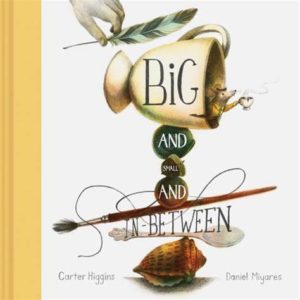 PZM: Big and Small and In-Between by Carter Higgins and Daniel Miyares.
PZM: Big and Small and In-Between by Carter Higgins and Daniel Miyares.
RVC: What’s your favorite comment from a kid about you or your books?
PZM: I went back to the elementary school I graduated from and did a presentation there. They were obviously really happy to see me, and they made a big deal out of it. When I was done, this little boy with a mohawk–a tiny little kid with a big mohawk–ran up, threw his arms around me, and yelled, “I hugged the famous person!” and then ran off before I could even respond.
RVC: Thanks so much, Pat–this was great! Leave it to two Wisconsin folks to make the magic happen. 🙂


Love this!! Pat is one of my favorite authors, love her books, love her attitude, her advice, and now her story! Thanks for sharing. Also love to hear that she gets super anxious before a school visit — I can’t imagine doing one, eek! She’s a great writer and definitely inspiring. This was fun to read.
Agree completely. Pat did a great job here!